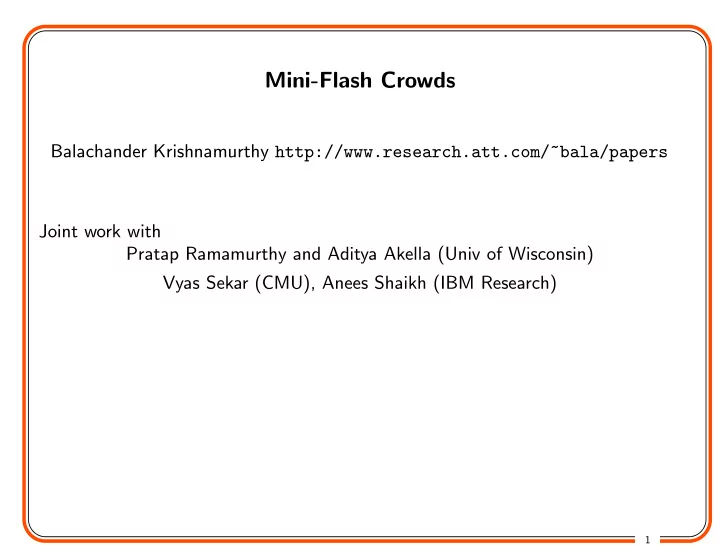

Mini-Flash Crowds Balachander Krishnamurthy http://www.research.att.com/~bala/papers Joint work with Pratap Ramamurthy and Aditya Akella (Univ of Wisconsin) Vyas Sekar (CMU), Anees Shaikh (IBM Research) 1
Inferring resource constraints of remote Web servers Motivation • Identify resource constraints in infrastructure • Site operators can test ability to withstand real load • Identify specific resources that are taxed • Improve infrastructure against simultaneous legitimate requests (this is not DDoS mitigation work) 2
Flash Crowds • 1971 Larry Niven science fiction short story, many people could teleport to see historical events anew. • Too many people wanted to go to the same day - flash crowd • Victoria Secret webcast, WCS, Olympics – but one can provision for these • Slashdot effect • On social networks: ”samy is my hero” XSS worm (via AJAX + js added his profile to 1M other myspace users) 3
Mini-Flash Crowds • What if you are able to cause an increase in load on a site... • ...without it being appreciable (i.e., site does not notice it) • Yet it is possible to Understand the response curve Infer bottlenecks Estimate possible tipping point 4
What is a MFC? • A set of controlled measurements • From a steadily increasing number of clients (with limit) • Synchronized requests to server being tested • Various request types to exercise Network bandwidth Local disk CPU Back-end database • Other resources can also be tested 5
Key insight • Watch for small but discernible increase in response time • Slow but steady increase in # of clients (and simultaneous requests made) • Initial response time increase threshold • If increase noticed, we stop • If maximum number of clients is reached without increase, we stop 6
Key advantages • Light-weight experiment setup • Non-intrusive wrt server (we lose if we are detected) • No involvement from production servers (if available, we can do better) • Real/distributed set of clients: reflects wide-area network conditions 7
MFC experiment structure 8
Experiment flow: Profiling stage • Crawl subset of site, classify objects (html, binary, images, queries..) • Obtain meta-information (e.g., size) via HEAD and categorize into small objects ( < 10KB), large objects ( > 100KB) • Use GET for small queries (also < 10KB) 9
Experiment flow: Object and base stages • Initial list of clients send synchronized requests • Requests vary with object type • Unique small object and small query (when available) impacting disk and database back-end • Same large object impacting access bandwidth • Base stage: HEAD request for index.html - baseline for request processing 10
Validation: Identifying Resource constraints Aim: Narrow down impact on specific server resources • Clients on LAN, local server (Apache 2.2, Ubuntu Edgy 2.6.* kernel) • atop used to monitor server resources: CPU, memory, disk accesses, network usage. Crowd sizes from 15-50 with increments of 5. • same small objects: Disk caching seen • unique small objects: 20x response time increase (more disk reads) • 100KB large object: Network bandwidth constraint increases response time significantly • Backend database used to examine same and unique queries (with both FastCGI and Mongrel interfaces) - unique showed higher CPU utilization 11
Wide area experiment-1: Web sites • Base stage of MFC (HEAD request) over 1 week from 65 P’lab clients • Against 200 live Web servers • Stopping threshold 100ms • Small enough to be not very intrusive at a site • Large enough for website to worry human-perceived interaction time • Threshold could be a function of the base response time and type of experiment (large vs small object) etc. 12
Wide area experiment-1: Web sites (continued) • Sites grouped into categories based on Alexa reach-per-million (rpm of 1000 means 1000 out of 1 million users visited it) • Crowd size at which degradation of > 100ms response time seen, broken down by crowd size values into sub-ranges • Larger reach categories show smaller fraction of servers that degrade • Surprisingly > 30% of sites even in 1000-10000 rpm range show degradation with < 65 simultaneous requests. 13
Stopping crowd sizes for various rpm with HEAD request 0.8 Fraction of servers with stopping crowdsize 10−20 20−40 40−60 0.7 60−70 0.6 0.5 0.4 0.3 0.2 0.1 0 1−10 10−100 100−1000 1000−10000 ALEXA Reach 14
Wide area experiment-2: Phishing Sites • Curious how such sites are provisioned; small study • 44 different phishing sites, 40 showed a 100ms response time increase with a crowd size less < 45, 27 with crowd size < 15 • Compared to Web servers in rpm 1-10, fraction of sites was 40% • Most phishing sites are hosted on low-end servers as one would expect 15
Discussion • Differences with real flash-crowds: controlled setup, so requests look normal. We ensure no sudden surge. • Limitation: strictly response-time increase based and thus black-box • Assumption: server load increase monotonically with crowd size. Not true if server caches objects, multiple replicated servers are used, dynamically re-provisions – so absence of response time increase can be inferred as well-provisioned. 16
Discussion - continued • Multi-server Websites: We assume single IP address/single host - invalid for sites using load balancing, CDNs. MFC cannot handle reactive load balancing techniques well, yet. • Security Implications: Parameters chosen to ensure non-intrusiveness • Implementation inefficiencies vs. Performance prediction: We want to identify implementation inefficiencies/resource bottlenecks and provide a framework for site admins to predict performance under load. We can do former; latter goal requires providing a full load-response curve. • Implications for Administrators: Need meaningful suggestions for network operators. 17
Recommend
More recommend